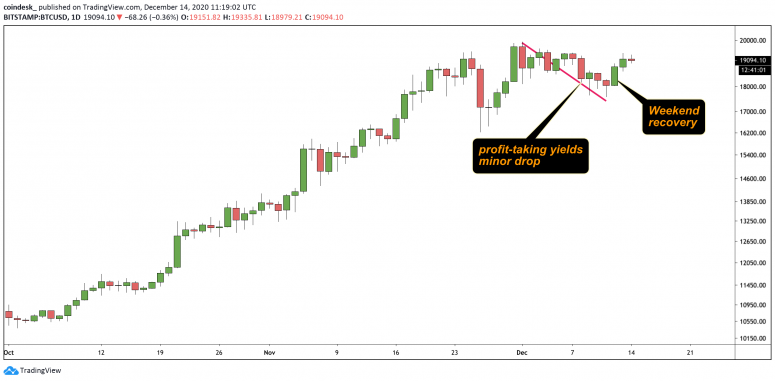Bitcoin was lower on Monday, holding just above $19,000 after rallying about $1,000 over the weekend.
“There is an element of fatigue, with the market unable to drum up the momentum needed to spur us to new highs,” Matt Blom, head of sales and trading for the cryptocurrency firm Diginex, told clients in an email.
In traditional markets, European shares rose the U.K. and European Union agreed to extend talks over a Brexit-related trade deal. U.S. stock futures pointed to a higher open as lawmakers in Washington continued negotiating a new stimulus stimulus package.
Market Moves
For so many reasons, 2020 will go down in history books. For many of those same reasons, it could go down in economics textbooks.
This year saw the biggest dropoff in economic activity since the Great Depression, the biggest money-printing episode in the Federal Reserve’s 107-year history, an epochal shift toward remote working, negative prices for crude-oil futures and the first real signs that the global financial system might be migrating toward fast-growing markets for cryptocurrencies and digital assets.
Bitcoin was invented just 11 years ago as the first and original cryptocurrency, intended for use in an electronic peer-to-peer payment system that wouldn’t be controlled by any person, business or government. At the start of the year, bitcoin was still considered a fringe investment, disparaged by the likes of the billionaire investor Warren Buffett as having “no value.”
By the end of the year, bitcoin had pushed to the center of conversations among big investors and Wall Street firms — cast by proponents as a hedge against the potential currency debasement that might come from trillions of dollars of coronavirus-related stimulus money emanating from central banks and governments around the world. Others saw growing mainstream acceptance of the cryptocurrency and its underlying blockchain network as validation of a landmark technology that might forever change finance.
Whatever the case, the bitcoin market in 2020 offered as good a prism as any through which to view the year’s monumental economic developments – and the responses to the crisis from national authorities and monetary policymakers.
Over the course of the next several days, First Mover will provide a recap of how the bitcoin market evolved over the course of the year, with prices for the cryptocurrency nearly tripling, attracting bullish commentary from big traditional-finance players including JPMorgan Chase, BlackRock, AllianceBernstein, Morgan Stanley and Tudor Investment.
That story might really represent another way of recounting the broader narrative in which low interest rates and the dollar’s reign as the global reserve currency allowed the U.S. government and its corporations to amass a heavy debt load in the years before the coronavirus hit. Once it did, the response was to invoke what one leading economist described as the “war machine” – the Federal Reserve financing U.S. government emergency-relief packages costing trillions of dollars.
Eventually markets from stocks to bonds became hooked on the expectation that stimulus would be provided in amounts needed to keep investors from suffering losses deep enough to impair confidence and derail the economic recovery.
All the while China pushed forward with its plan to roll out a digital version of its yuan, raising the specter that a virtual currency from the world’s second-biggest economy might eventually challenge the U.S. dollar’s dominance in payments for global trade. In the U.S. and elsewhere, billions of dollars of venture capital and trader money flowed into an array of obscure digital tokens on blockchain-based, semi-autonomous trading and lending systems — collectively known as “decentralized finance,” or DeFi; the fast-paced growth suggested that digital-asset markets might represent a haven of innovation in an otherwise stagnant global banking system.
Whether due to causation or correlation or merely wishful thinking, the bitcoin market, long viewed as a hotbed of volatility and unfettered speculation, suddenly seemed to rise with nearly every new twist.
Coming Tuesday: Even before the coronavirus hit, bitcoin traders and mainstream economists alike were growing increasingly concerned about the slowing U.S. economy, rapid growth in corporate debt and whether the dollar faced growing threats to its global monetary hegemony.
Bitcoin Watch

Bitcoin’s revived uptrend could soon lead to a much-anticipated breakout above the $20,000 mark.
“We have witnessed a large move up over the weekend, with MicroStrategy’s efforts to increase bitcoin holdings from several large players bringing with it fresh optimism,” Matthew Dibb, CEO of Stack Funds, told CryptoX. “Our belief is that we will see a breach of $20,000 in the coming weeks.”
On Friday, business-intelligence firm MicroStrategy raised $650 million through a convertible senior note sale to fund bitcoin purchases; the deal was upsized from $550 million. Since then, the cryptocurrency has rallied by over $1,000 and was last seen trading near $19,100, according to CryptoX 20 data.
The cryptocurrency nearly doubled from $10,000 to a new record high of $19,920 in the 12 weeks to Dec. 1, before falling to $17,700 last week amid a bout of profit taking. Pullbacks are a normal element of bull markets and often recharge the engines for a bigger ascent.
Kenetic Capital’s CEO Jehan Chu also foresees bitcoin marching onward with “two steps forward, one step back” price action. The breakout, however, may remain elusive until the new year, as some investors are still looking to sell around record highs.
“The topside is still kept with lots of selling orders, possibly from miners,” Patrick Heusser, head of trading at Zurich-based Crypto Broker AG, told CryptoX over Twitter.
What’s Hot
Fidelity’s Abigail Johnson says cryptocurrency industry is moving so quickly that “trying to keep up with it is very hard” (CryptoSlate)
Bitcoin is a “fascinating representation of animal spirits and speculation,” DoubleLine’s Jeff Gundlach says (Business Insider)
An additional $600B of bitcoin demand could materialize if pension funds and insurance companies in the U.S., euro area, U.K. and Japan allocate 1% of portfolios to the asset, compared with the cryptocurrency’s current market capitalization of about $350B, JPMorgan analysts write in new report (Bloomberg)
Wall Street heavyweights moving into bitcoin are the enemy to many who hail from the cryptocurrency’s cypherpunk roots, CryptoX’s Michael Casey writes in Money Reimagined newsletter (CryptoX)
China aims for gradual consumer adoption of digital yuan, former central bank governor Zhao says (South China Morning Post)
19-year-old Ukrainian lawmaker discloses ownership of $24.5M of cryptocurrency monero (CryptoX)
Sygnum, a digital-asset firm with a Swiss banking license, claims to be first bank in world to tokenize its own shares (CryptoX)
Aegis Custody clears hurdle in bid for South Dakota trust charter (CryptoX)
CEO of DeFi insurer Nexus Mutual hacked for $8M in NXM tokens (CryptoX)
Bitcoin exchanges flood London’s Metro with ads (CryptoX)
Analogs
The latest on the economy and traditional finance
Morgan Stanley says there’s a chance a no-deal Brexit could prompt Bank of England to cut benchmark interest rates below zero (Reuters)
Remote-working shift loosens Silicon Valley’s tight grip on tech industry (WSJ), and Google opens door to “flexible workweek” (NYT)
Shandong Ruyi Technology Group, once considered the “LVMH of China,” cancels bondholder meeting over possible debt-maturity extension as coronavirus exacerbates “liquidity pressure” and interest payment looms this week (Nikkei Asia Review)
Suspected Russian hackers are believed to have broken into the U.S. Treasury and Commerce departments and have been monitoring internal email traffic (Reuters)





